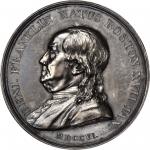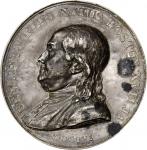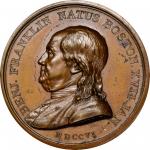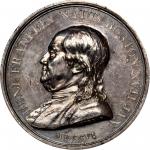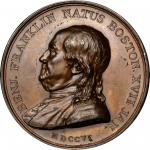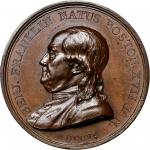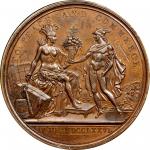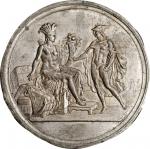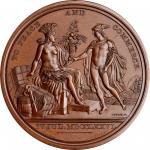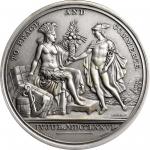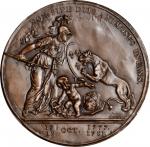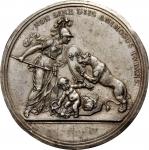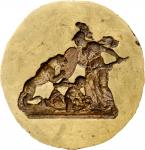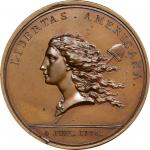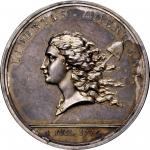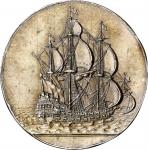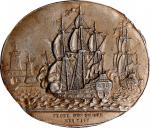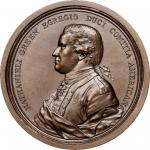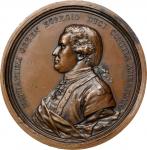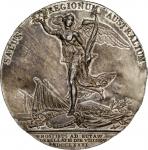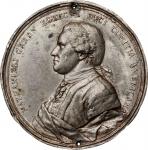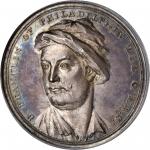1777 B. Franklin of Philadelphia medal. Betts-547. Silver. Unidentified English medalist. 45.2 mm. 799.2 grains. 3.5 - 3.7 mm thick. Choice About Uncirculated.Plain edge with gently beveled rims. A strong candidate for the prettiest of all medals in the Adams Collection, with deeply reflective and highly lustrous surfaces showing elegant toning in shades of pale blue, rose gold, violet, and brilliant silver gray. An exceptionally appealing medal, showing a three-quarter facing portrait of Franklin that is as distinctive as it is expertly accomplished. Multiple strikes were required to bring the portrait into full relief, perhaps three based upon the appearance of the peripheral legends. The visual appeal of this specimen exceeds even the remarkable elegance of this medals workmanship.<p>The Adams and Bentley census lists four of these in silver: British Museum, this example, "Wayte Raymond Estate," and "Greenslet Plate coin." The Raymond estate was acquired by Ford. Had there been one in the Raymond estate, presumably he wouldnt have needed to acquire this one in 1967. Of course, Wayte Raymond bought and sold a lot of things, quite possibly including this piece at some period in between Medinas death in 1930 (when Raymond was perhaps the biggest dealer of Numismatic Americana in the country) and this medal resurfacing in 1967. As for the Greenslet plate coin, the plate piece is depicted in black and white with no assurances of its composition. Until either the Wayte Raymond piece turns up, or Greenslets is discovered to be silver rather than just a very nice copper example, we will remain firm in our suspicion that this medal is unique in private hands. <p>More than a decade has passed since this piece brought $92,000 in Ford XIV, where Michael Hodder called it "the most important of all the Franklin medals" in boldface type. Its production during the annus horribilus of 1777 makes it all the more remarkable. While George Washington ached from his terrible loss at Brandywine, blood had yet to dry at Paoli, and General William Howe made himself comfortable in Franklins Philadelphia, British allies treasonously celebrated Americas new minister to France with this hagiographic medal. Franklin arrived in Paris around Christmas 1776. While he celebrated his 1777 Nini portrait in terre-cuite to an embarrassing degree, he never commented on this medal - he may never have seen it. As Adams and Bentley wrote of this rarity, "in the end, the secret of this medal is that it is a secret medal."<p><strong>B. Franklin of Philadelphia</strong><p>Benjamin Franklin was a human Rorschach test among educated citizens of the Western World during the late 18th century. A savvy politician in England, an avatar of enlightened simplicity in France, a living manifestation of the American obsession with Horatio Alger-style success stories, or a self-interested operator who manipulated people and public opinion to achieve his goals: Franklin was all of these things. He was the quintessential American yet lived abroad for most of his adult life, a lover of women but abandoned his wife, and a middle class tradesman who amassed great wealth. His medallic portraiture reflects all of these poses and contradictions: learned titles when he needed to affect sophistication, a fur hat when he needed to be approachable, a fresh face that communicated youth and experience when his country needed both steadiness and exuberance. His depictions are fascinating, both during his life and after.<p>The origins of the 1777 B. Franklin of Philadelphia medal are obscure. The distinctive portrait, and the unusual basining of the reverse, bring to mind a group of medals that are clearly related: the 1778 Washington "Voltaire" medal, the 1777 Chevalier DEon medal, and the 1776 David Hume medal. Tony Lopez did a good job punchlinking this group in the June 2008 MCA Advisory, and finding that a group of medals shares a punchset is good evidence if not a slam dunk that they come from the same workshop. The August 2008 issue of the same journal features a detailed examination by the English medal mensch Christopher Eimer, reflecting on the conversation he and Richard Margolis had shared years earlier discussing many of the same connections among these medals, while cautioning that little evidence connects these medals to the liberal-minded ceramics makers Wedgwood and Bentley.<p>It is safe to assume that, despite the long-standing attribution of the "Voltaire" medal to France, these medals are all of English manufacture. DEon was a cause célèbre in England in 1777 and Hume, of course, was a Scot. Attribution to a particular medalist would be absolute guesswork, as none of the medals are signed - unless the "F" that follows the 1777 date on the DEon medal is a signature (Flaxman?). The medals all have in common a certain liberal, internationalist mindset, all of which would have been appealing to the same kind of crowd.<p><p>This medal has often been laid at the feet of Josiah Wedgwood and Thomas Bentley, makers of medallions (ceramic, not metal) who shared this sort of political perspective. The "brazen head" mentioned in Grueber and the Adams-Bentley work is undoubtedly Washingtons, not Franklins based on the context of the quoted letters. Franklin was not, as Wedgwood wrote, "more absolute than any Despot in Europe," but Washington was - he was called "dictateur" on a popular French engraving published in 1777.<p>So while we cannot identify the medalist, we can certainly narrow down the mindset, the crowd, and the political perspective that would inspire a medal of Franklin at a time that he was the most famous face of a treasonous band of colonists. And this medal doesnt just evoke Franklin, it celebrates him: mentioning his honorary degree from the University of Saint Andrews and his fellowship in the Royal Society. The medals pose and inscription are based upon a print of Franklin by Edward Fisher published in 1763, when Franklin was the toast of London, an ally and a strong advocate for the government of George III. This pro-Franklin obverse juxtaposed with his immovable strength - like a tree in a lightning storm - all during the Revolutionary tumult of 1777 makes for a highly charged political statement.<p><strong>Obverse:</strong> A three-quarter left portrait of Benjamin Franklin, depicted with a velvet turban, based upon Edward Fishers 1763 print. The inscription B. FRANKLIN OF PHILADELPHIA L.L.D. & F.R.S. identifies him as a Doctor of Laws (Honorary, University of Saint Andrews, 1759) and a Fellow of the Royal Society.<p><strong>Reverse:</strong> A lone tree attracts a lightning bolt, with the peripheral legend NON IRRITA FULMINA CURA, which Adams and Bentley translate as "He is not perturbed by the futile lightning bolts" and for which Betts offers the inscrutable "He cares not for the ineffectual thunderbolt." Charles Coleman Sellers uses Herbert Gruebers better translation: "He stands impervious to the futile thunderbolt." The sense of the expression is something along the lines of "He doesnt care how the lightning strikes," suggesting steadfastness in the face of danger while punning on Franklins famed taming of electricity. The date J777 + seems unusual, though J was often used for 1 on coin and medal productions in England in this era, and the cross decoration is seen as a spacer on the Hume medal, among others.<p><p>From the John W. Adams Collection. Acquired from our sale of the John J. Ford, Jr. Collection, Part XIV, May 2006, lot 336. Earlier, Jose Toribo Medina Collection; plated in Medina’s 1924 Medallas Europeas Relativas a América, figure 154; Colony Coin Company, August 1967.



